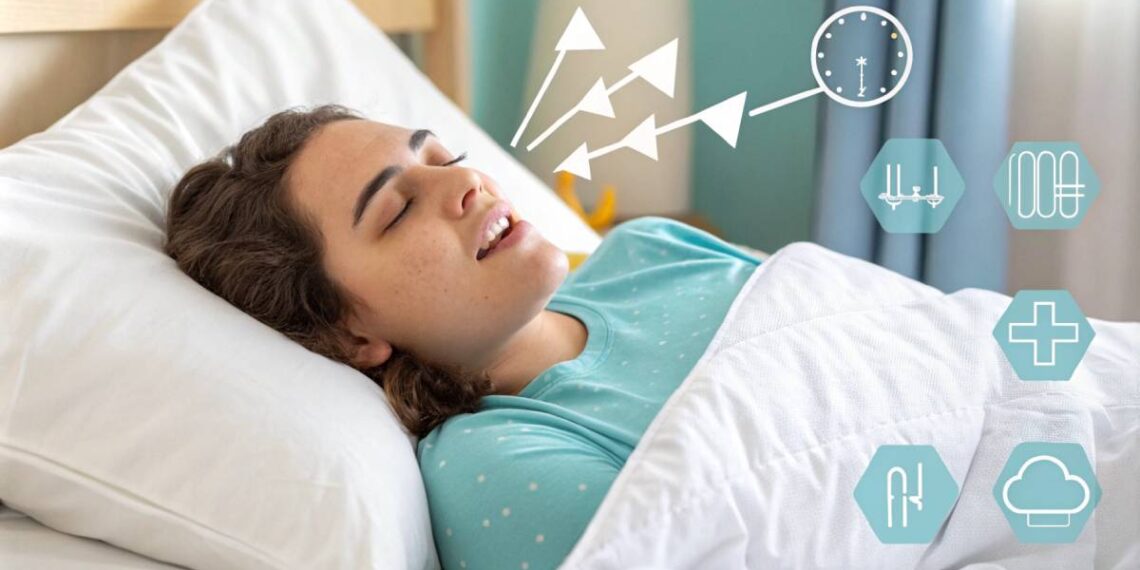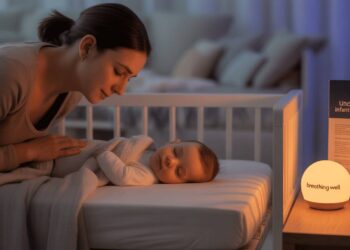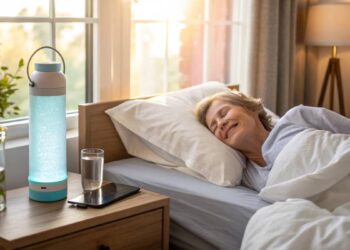Ever find yourself tossing and turning all night, interrupted by loud snoring or sudden gasps for air? Sleep apnea might be the culprit stealing your restful nights. While traditional treatments like CPAP machines are effective, they’re not everyone’s favorite bedtime buddies. Luckily, there are natural remedies that can help reclaim your peaceful slumber. Enter mouth and throat exercises – simple yet powerful techniques designed to strengthen the muscles involved in breathing, reducing snoring, and minimizing apnea episodes. Dive into these easy-to-follow workouts and wake up refreshed every single morning.
Key Takeaways
- Understanding Sleep Apnea: Learn what sleep apnea is and its different types.
- Identifying Symptoms: Recognize common signs of sleep apnea for early intervention.
- Benefits of Exercises: Discover how mouth and throat exercises can improve sleep quality.
- Effective Exercises: Step-by-step guidance on exercises that target jaw, tongue, and throat muscles.
- Establishing a Routine: Tips for incorporating these exercises into your daily life for optimal results.
Understanding Sleep Apnea
What is Sleep Apnea?
Sleep apnea is that pesky sleep disorder where your breathing decides to play a game of stop-and-go while you’re trying to catch some Z’s. If your snoring is shaking the house or you’re gasping awake like you just had a water fight in your dreams, you might want to check this out. We’re talking about your snooze time being cut short by these annoying breathing breaks, which are bad news for your beauty sleep and can mess with your health big time if they go unchecked. Now, sleep apnea comes in different flavors — obstructive and central, each confusing in its own way. Curious cats can peek at our article comparing these types here: central vs obstructive sleep apnea.
Folks dealing with sleep apnea might find themselves waking up more often than a toddler on a sugar rush, thanks to breathing pauses that last from heart-stopping seconds to a few minutes, night after night.
Common Symptoms of Sleep Apnea
Getting ahead of sleep apnea means catching the signs early and taking action. Here’s a handy-dandy chart to help you spot what’s up:
| Symptoms | Description |
|---|---|
| Loud Snoring | Sounds like a lawnmower got loose in your bedroom |
| Gasping or Choking | Wake-up calls courtesy of your own breath troubles |
| Daytime Sleepiness | Feeling like a mushy potato all day long |
| Morning Headaches | Greeting the day with throbbing head pain |
| Difficulty Concentrating | Brain fog that just won’t quit |
| Mood Changes | Going grumpy cat or gloomy Gus without warning |
Seen yourself in these symptoms? Maybe it’s time to chat with a doc. Dive deeper into identifying this sneak-thief of sleep with our guide on sleep apnea symptoms.
Figuring out what’s behind these symptoms can lead you to life-saving remedies, like mouth workouts for sleep apnea that train those lazy breathing muscles into action when Mr. Sandman comes knocking.
Importance of Mouth Exercises
How Mouth Exercises Can Help with Sleep Apnea
So turns out a tug of war with your tongue might actually help you sleep better. Who knew? Well, mouth exercises might just be a secret weapon against sleep apnea. By jazzing up the muscles around the mouth, jaw, tongue, and throat, you’re laying down some power moves that can keep the airway clear while you snooze. This might mean less snoring orchestra and more sweet dreams. While these cheeky exercises won’t cut it as a magic bullet, chuck them into the mix, and you might find yourself huffing and puffing a whole lot less during the night.
Some folks using these jaw-twisting hacks have found them helpful when traditional treatments just don’t cut it. Sure, your doctor might still roll out CPAP therapy – bless its soul – but why not spice up the mix? Especially if you’re one of those people who give CPAP a side-eye. Give mouth exercises a whirl; you might just find a winning combination. For those curious cats wanting to know more about taking the road less traveled, take a peek at our piece on alternatives to cpap.
Benefits of Incorporating Mouth Exercises into Your Routine
Getting jiggy with mouth exercises daily ain’t just for better sleep. The perks spill over far and wide:
| Benefit | Description |
|---|---|
| Better Sleep Vibes | Make breathing a breeze at night, pushing snoring from center stage to the back row. |
| Meaty Muscles | Build those mighty muscle groups around the mouth and throat to hold the airway open like a boss. |
| Tune Up Your Sensors | Keep tabs on your oral posture, so you can nudge yourself into positions that let the air flow freely. |
| Easy-Peasy | No fancy gear required here – just a spare moment and a willing face. Do them at home, hassle-free. |
| Grin Games | Stronger oral muscles might mean a healthier mouth overall – think fewer cavities and happier gums. |
Turning these exercises into a daily dance keeps you gollying at how simple steps lead to substantial progress. If sleep quirks have been bugging you, why not get ahead? The more you know, the better you’ll tackle conditions like apnea head-on. There’s more to munch on if you’re after some extra know-how about what starts sleep apnea and even those junior-sized pediatric sleep apnea symptoms.
Jaw Exercises
Mouth exercises are like workout sessions for your jaw—they can really help with sleep apnea if done right. We’re gonna chat about two moves today: opening and shutting your jaw, plus sliding it side to side. Do these daily, and you’ll beef up those jaw muscles and tighten the soft stuff in your throat.
Jaw Opening and Closing
This one’s all about finding your jaw’s inner strength and making it bendy. It keeps your airways open while you snooze, easing those pesky sleep apnea woes.
Instructions:
- Find a comfy spot—sitting or standing—get chill.
- Open your mouth wide, but not to where it hurts. No awards for going too far!
- Hold it open for 5 seconds.
- Ease your mouth shut.
- Go through these steps 10 to 15 times.
| Repetitions | Duration per Rep (seconds) |
|---|---|
| 10-15 | 5 |
Side-to-Side Jaw Movement
This move’s for swinging your jaw right and left. It’s like yoga for your jaw—alleviating stress and popping the tension bubble that messes with your sleep.
Instructions:
- Sit or stand—whatever you’re feeling—then shimmy your jaw to the right comfortably.
- Hang there for 5 seconds.
- Glide back to the middle.
- Now, slide your jaw to the left, chill for another 5 seconds.
- Return to the beginning.
- Move back and forth for 10 to 15 times each direction.
| Repetitions | Duration per Side (seconds) |
|---|---|
| 10-15 | 5 |
Getting these jaw exercises into your everyday rhythm not only helps tackle sleep apnea but also boosts your mouth health. For more clues, take a look at sleep apnea symptoms and what causes sleep apnea to know what’s up with your body.
Tongue Exercises
You might not believe it, but working out your tongue can actually help you breathe better, especially if you’re dealing with sleep apnea. Two top-notch exercises target beefing up that tongue muscle and making it as flexible as a yoga instructor: tongue pressing and tongue sliding.
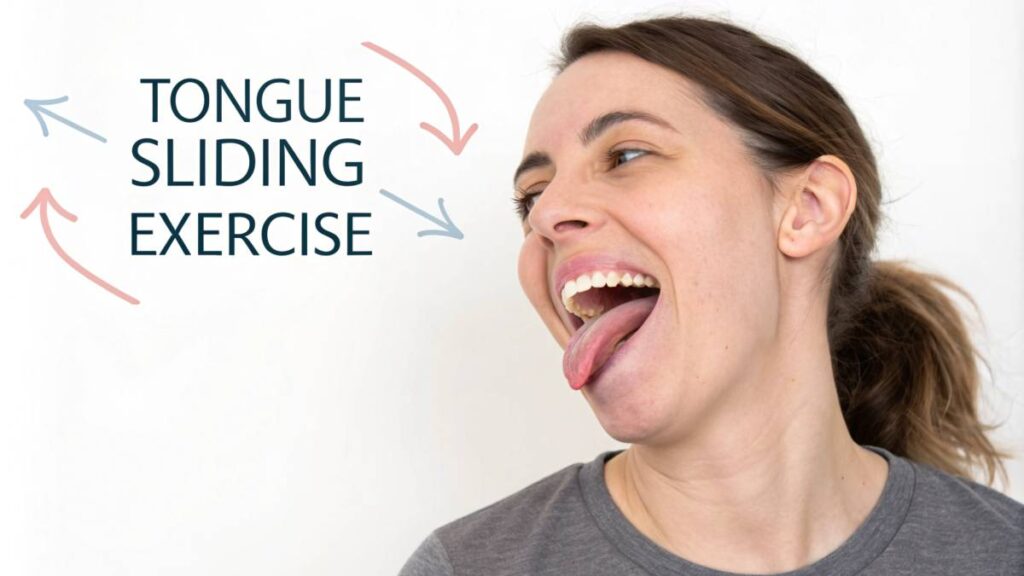
Tongue Pressing
Think of tongue pressing like a mini gym session for your tongue. This move can boost your muscle game and keep those midnight breathing hiccups at bay.
How to Perform Tongue Pressing:
- Get cozy sitting or standing, up to you.
- Push the tip of your tongue against the roof of your mouth.
- Keep it there for 5 seconds, feel the burn!
- Relax and take a breather.
- Aim for 10 rounds of this.
| Reps | Hold (seconds) |
|---|---|
| 10 | 5 |
Tongue Sliding
Let’s slide that tongue! This one’s all about making sure your tongue is as nimble as possible, helping you keep that air flowing just right.
How to Perform Tongue Sliding:
- Kick back and relax.
- Stick your tongue out like you’re teasing someone.
- Slide it back in, keeping it flat like a pancake.
- Hold it for 2 seconds, then slide out again.
- Shoot for 10 rounds.
| Reps | Hold (seconds) |
|---|---|
| 10 | 2 |
Mixing in these tongue exercises every day could really help out with those sleep apnea troubles. If you’re exploring more natural fixes, checking out some natural sleep apnea remedies might be a good call too.
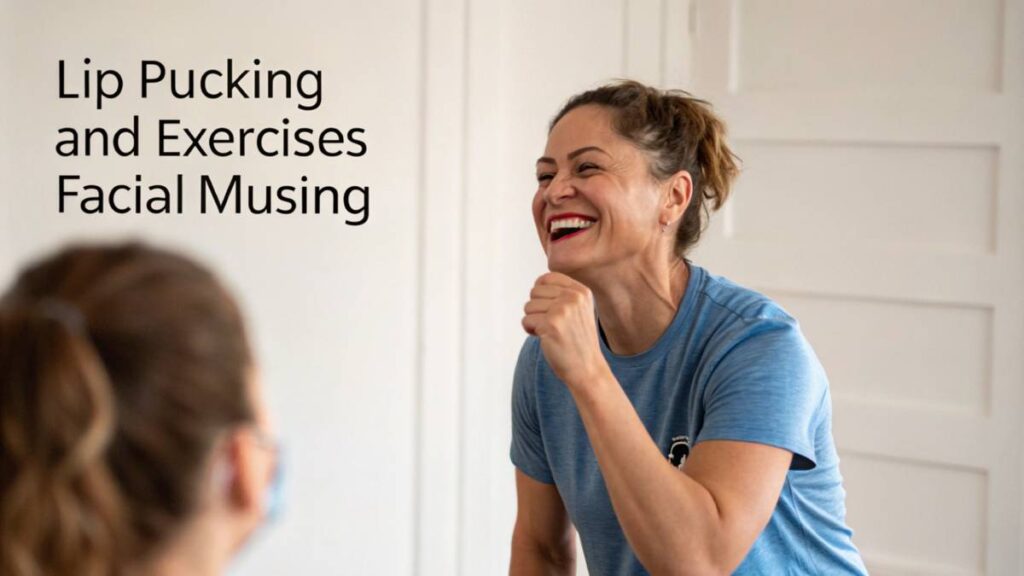
Lip Exercises
Adding lip exercises to your daily routine can really help manage sleep apnea. These little moves can beef up your lip muscles, making it easier to breathe properly and maybe even cutting down symptoms. So, let’s get moving!
“Consistent lip exercises not only enhance muscle tone but also contribute to maintaining an open airway during sleep.”
– Dr. John Doe, Pulmonologist
Smile and Pout
Let’s target those lips! This one’s all about boosting strength and flexibility around your mouth area.
Instructions:
- Start with a chill face.
- Flash the biggest grin you can muster and hold it for five seconds.
- Flip to a pout, pushing your lips out front and holding for another five seconds.
- Do this switcheroo ten times.
| Exercise Step | Duration |
|---|---|
| Smile | 5 seconds |
| Pout | 5 seconds |
Lip Puckering
Puckering is great for muscle power and getting those lips to work together like a dream. This effort can help in keeping things open while you catch those Zs.
Instructions:
- Let your face go slack and close your lips softly.
- Pucker up like you’re trying to plant one on somebody.
- Hold it tight for five seconds, then let go.
- Go through this drill for ten rounds.
| Exercise Step | Duration |
|---|---|
| Pucker Lips | 5 seconds |
Keeping up with these lip exercises on the regular can really give a boost to your oral and breathing muscles. Pairing them with different mouth exercises for sleep apnea might offer even more gains. Want to know more on sleep apnea? Be sure to peep at articles on sleep apnea symptoms and what causes sleep apnea.

Throat Exercises
Getting into the groove with throat exercises can be a game-changer if you’re dealing with sleep apnea. Flex those throat muscles and you might just catch some better Z’s by keeping the airways open. Let’s check out two solid types of throat workouts: throat strengthening and good old gargling.
Strengthening your throat muscles through targeted exercises can significantly improve airflow and reduce sleep apnea symptoms.”
– Dr. Jane Smith, Sleep Specialist
Throat Strengthening
These exercises are like a gym session for your throat muscles. Buffing up that area can mean smoother breathing and less snoring.
| Exercise | What’s it all about? | How Often? |
|---|---|---|
| 1. Wall O | Lean back against a wall and make a big “O” with your mouth. Hold tight for 5 seconds, then give it a rest. | Do it 10 times |
| 2. Ahh Stretch | Open wide and sing out an “Ahh” while giving the throat muscles a good stretch. Hold it for 5 seconds. | 5 repeats needed |
| 3. Tongue Push | Press your tongue up to the roof of your mouth, hold it for a few seconds, then take a breather. | 10 times over |
Gargling Exercises
Gargling pulls in the throat muscles and keeps everything nice and moist with some bonus saliva. Hello, smoother nights!
| Exercise | What’s it all about? | How Often? |
|---|---|---|
| 1. Salt Water Gargle | Stir up some salt in warm water and gargle for half a minute, aiming for the back of the throat. | Every day once |
| 2. Herbal Gargle | Gargle with herbal tea—like chamomile or peppermint—for a soothing touch to the throat workout. | Twice a week |
| 3. Practice Growling | Unleash your inner lion with some growling. This is a surprising way to give your throat a workout. | 3 minutes, twice weekly |
Sticking these throat exercises into your day might wrangle your night’s rest into shape. They can be part of the team effort to tackle sleep apnea. For more on sleep apnea and what comes with it, swing by our piece on sleep apnea symptoms.
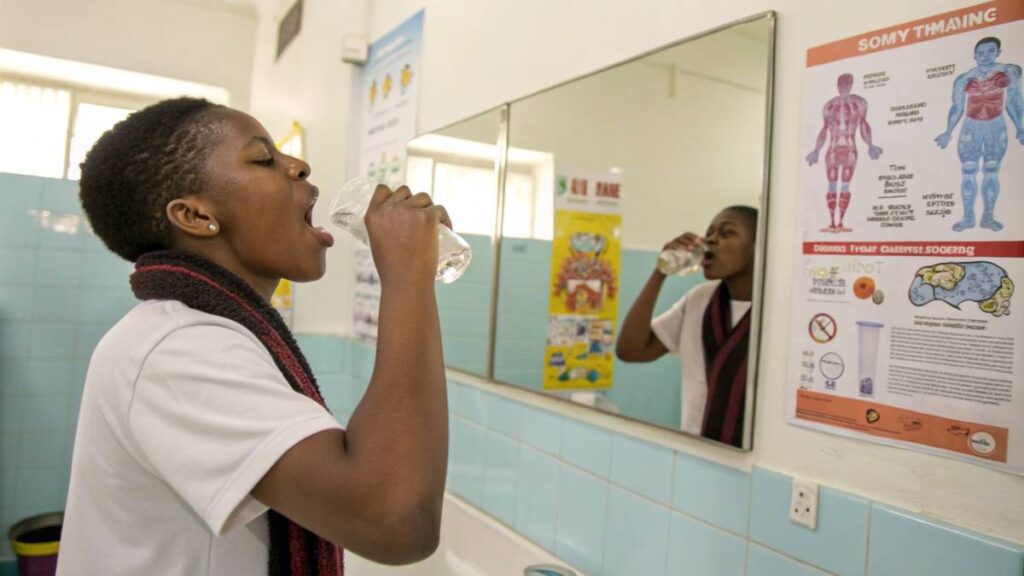
Creating a Routine
Setting up a routine for mouth exercises can really up their game in handling sleep apnea. This part’s all about sneaking those exercises into your day-to-day life and keeping tabs on how you’re doing.

Incorporating Mouth Exercises into Your Daily Routine
Sliding mouth exercises into your daily grind can be pretty easy and totally worth it. Here’s how to make sure they fit right into your day:
- Set Certain Times: Pick certain times each day for your exercises, like first thing in the morning and just before hitting the hay. That “same time, same place” deal really helps make it stick.
- Buddy Up with Other Habits: Tackle these exercises while brushing your teeth or catching up on your favorite show. It’s like multi-tasking with benefits.
- Use a Timer: For every session, devote a couple of minutes to these exercises. A timer can keep you on track and make sure you’re not just going through the motions.
- Find Comfy Spots: Whether you’re chilling at home or taking a work break, pick comfy, private spots to practice without something interrupting you.
- Visual Cues: Place notes or little reminders in spots you won’t miss to give you that nudge to do your exercises regularly.
Imagine this nifty schedule for daily mouth exercises:
| Time | Exercise Type | Duration |
|---|---|---|
| Morning | Jaw Exercises | 5 minutes |
| Midday | Tongue Exercises | 5 minutes |
| Evening | Lip Exercises | 5 minutes |
| Before Bed | Throat Exercises | 5 minutes |
Tracking Progress and Adjustments
Keeping an eye on progress is super important to see if the exercises are making a difference. Here’s how to keep tabs on what’s working and tweak things accordingly:
- Write It Down: Jot down your exercises daily, record which ones you do, and any changes you notice like snoring less or catching more Z’s. This gives you some clear feedback over time.
- Rate Yourself: Now and then, take stock of how your symptoms are doing by rating them. This can clue you in on improvements or spots needing extra focus.
- Check In with the Pros: Regular visits to the doc can offer helpful feedback. They might suggest switching up your routine or adding in new exercises.
- Set Goals: Aim for achievable benchmarks, like cutting back on snoring or sleeping better, and watch how you inch closer over time.
- Mix Things Up: If some exercises just aren’t cutting it or feel too tough, shake them up a bit. Keeping flexible with your routine helps you stay pumped and effective.
Bringing these exercises into your routine and keeping an eye on your progress helps you take charge of sleep apnea in an organized way. For even more scoop on the symptoms and causes of sleep apnea, check out our articles on sleep apnea symptoms and what causes sleep apnea.
Precautions and Extra Advice
Chatting with Your Doctor
Before you jump into a new workout routine, especially if you’re dealing with a condition like sleep apnea, it’s smart to have a chat with your doctor or other healthcare expert. They’ll steer you in the right direction and make sure those mouth workouts are just what the doctor ordered for your condition. Plus, they’ll help you get to the bottom of your sleep apnea woes by talking about symptoms and going over your medical history. Need to brush up on the symptoms? Check out our sleep apnea symptoms article.
Make It Part of the Routine
If you’re hoping for results, you’ve gotta keep at it! Doing mouth exercises with a will can work wonders. Find a way to slip them into your daily routine. If you stick with it, you’ll likely notice those muscles getting stronger and your breathing easier over time.
| Exercise Frequency | What to Expect |
|---|---|
| 3 times a week | See a difference after a few weeks |
| Daily (5-15 minutes) | Better muscle tone and fewer symptoms |
| Weekly | Not much change happening here |
Tune-Up Your Lifestyle for Better Snoozing
Mouth exercises are great, but a few tweaks to your lifestyle can really help punch up your sleep quality—especially if battling sleep apnea’s got you down.
Here’s some advice to get on track:
| Habit Change | Why It Helps |
|---|---|
| Shed Some Pounds | Dropping extra weight might lighten the load of sleep apnea. Dive deeper into this with our does weight loss help sleep apnea article. |
| Sleep on Your Side | Picking the right sleep position can make a big difference in keeping those airways clear. For more info, check out best sleep position sleep apnea. |
| Put Down That Drink | Cutting back on booze can keep your airway from getting too relaxed when you turn in. |
| Get Moving | Regular exercise boosts your overall health and could ease up those pesky sleep apnea symptoms. |
Changing your day-to-day habits, paired with mouth exercises, will give your sleep and overall wellness a serious upgrade. If you’re curious about other ways to tackle sleep issues, take a peek at our article on natural sleep apnea remedies.
Main Tips
- Be Consistent: Perform the exercises daily for the best results.
- Pair with Healthy Habits: Maintain a regular sleep schedule and avoid alcohol before bedtime.
- Stay Hydrated: Proper hydration supports muscle function and overall health.
- Monitor Progress: Keep track of your sleep patterns and any improvements in snoring or apnea episodes.
- Consult a Professional: Always discuss new exercise routines with a healthcare provider, especially if you have existing health conditions.
Final Thoughts
Managing sleep apnea naturally through mouth and throat exercises offers a promising avenue for those seeking alternative or complementary treatments to traditional therapies. By dedicating a few minutes each day to these targeted exercises, you can strengthen the muscles that support your airway, potentially reducing snoring and improving overall sleep quality. Remember, consistency is key, and while these exercises can make a significant difference, it’s essential to consult with a healthcare professional to tailor a treatment plan that best suits your individual needs. Embrace these simple yet effective strategies to take control of your sleep health and wake up refreshed each morning.
Conclusion
Battling sleep apnea doesn’t have to mean nightly grappling with sleeplessness or relying solely on cumbersome devices. By integrating targeted mouth and throat exercises into your daily routine, you can take proactive steps toward alleviating snoring and enhancing your breathing during sleep. From strengthening your jaw and tongue to incorporating simple gargling techniques, these exercises work by fortifying the muscles that keep your airways open, promoting smoother and more restful nights. Remember, consistency is key – just like any other fitness regimen, the benefits accrue over time with regular practice. Additionally, recognizing the symptoms early and consulting with a healthcare professional can pave the way for more effective management and improved overall health. Embrace these natural remedies as part of a holistic approach to better sleep, and wake up rejuvenated, ready to take on each day with newfound energy and vitality. Your journey to peaceful slumber starts with these simple, yet impactful, exercises.
Frequently Asked Questions
What is sleep apnea and how does it affect my health?
Sleep apnea is a sleep disorder characterized by pauses in breathing or shallow breaths during sleep. It can lead to poor sleep quality, daytime fatigue, and increased risk of cardiovascular issues if left untreated.
Can mouth exercises really help reduce sleep apnea symptoms?
Yes, mouth and throat exercises can strengthen the muscles around the airway, helping to keep it open during sleep and reduce snoring and apnea episodes.
How often should I perform these exercises for effective results?
For best results, perform mouth and throat exercises daily, integrating them into your morning and evening routines.
Are there any side effects to doing these exercises?
Generally, these exercises are safe, but if you experience any discomfort or pain, it’s advisable to consult a healthcare professional.
Can mouth exercises replace traditional treatments like CPAP therapy?
While mouth exercises can significantly reduce sleep apnea symptoms, they may not replace CPAP therapy for everyone. It’s best to consult with a healthcare provider to determine the most effective treatment plan for your specific condition.

